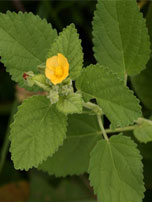SHAHEED KARTAR SINGH SARABHA AYURVEDIC MEDICAL COLLEGE & HOSPITAL
Affiliated to Guru Ravidas Ayurved University, Hoshiarpur Punjab
Affiliated to Guru Ravidas Ayurved University, Hoshiarpur Punjab

Botanical Name : Sida cordifolia Linn.
Family : Malvaceae
Introduction :
In North India Sida cordifolia considered as bala, but in south Sida rhombifolia Linn. Considered as bala. Whatever be, both of them have same use.
Names in different Indian languages :
English : Country Mallow
Hindi : Khirainti, Bariyara
Kannada : Hettuti
Malayalam : Vellurum
Sanskrit : Bala , maha bala
Tamil : Nilatutti
Telugu : Chittamutti, Mattavapulagam
Unani : Bariyaara, Khirhati, Khireti, Kunayi.
Synonyms :
Balaa, Sumanganaa, Kharayashtikaa, Balini, Bhadrabalaa, Bhadraudani, Vaatyaalikaa
Classification according to Charaka, Susrutha & Vagbhata :
Charaka
Balã, Brmhaniya, Prajãsthapana, Madhuraskandha
Susrutha
Vãtasamgamana
Vagbhata
malvaceae-sida root storage (5)
Varieties & adulterants – (CV – controversy, AD – adulterants) :
1. S.acuta Burm
2. S.rombifolia
3. S.restusa
4. S.spinosa
S. spinosa ( considered as mahabala)
Bhãvamisra mentioned four varieties
(i) Balã
(ii) Atibalã
(iii) Nãgabala
(iv) Mahã balã
S. cordifolia
Abution indicum
S. veronicaefolia
S. rhombifolia
Morphology :
A small downy erect herb or shrub, 1.2 m. in height, with long branches, sometimes rooting at nodes.
Leaves- cordate, oblong, ovate or ovate oblong, very downy on both surfaces; petiole as long as the blade.
Flowers small, tawny yellow or white, carpels 10.
Fruits- with a pair of awns on each carpel. (Flowers and grows wild along the roadsides, throughout sub-tropical and tropical India, ascending up to 1,200 m.)
Distribution & Habitat :
All over India
Chemical constituents :
Major components of seeds are alkaloids. Alkaloid contains mainly ephedrine. It also contains fatty acid, mucin, potassium nitrate and resin, hypaphorine, vasicinone, vascicine, vasicinol, choline, betaine, phytosterol, phytosterols, resin, resin acids, mucin and potassium nitrate. etc.
Properties :
RASA-madhur, kashaya
GUNA- Laghu, Snigdha, Picchila
VIRYA-sita
VIPAKA-madhur
Karma –balya, vranahara, rasayana, stambana, vrisya
Sour, astringent, acrid, spermatopoietic, demulcent, antibacterial and antipyretic
Indication :
Raktapitta, Vatavyadi, Prameha, Ksaya
Rheumatism, hemiplegia, facial paralysis, sciatica, polyuria, dysuria, cystitis, strangury , hematuria; leucorrhoea , general debility
Part used :
Root
Dosage :
Powder 2-4 g
Decoction 50-100 ml
External use :
Paste is analgesic and alleviates oedema. It is locally applied over inflammation and eye disorders.
Internal use :
Central nervous-system : Being neural tonic and vatasharnak, it is useful in vata disorders like paralysis, facial palsy etc
Digestive system : Emollient and astringent. Useful in flatulence.
Circulatory system : Cardiac tonic and alleviates
haemorrhagic disorders, hence used in cardiac debility, haemorrhagic disorders .
Reproductive system: Aphrodisiac and useful in spermatorrhoea
Urinary system : Diuretic, so useful in dysuria.
Temperature : Useful in fever being a febrifuge
Satmikaran : Being tonic, it is helpful in general debility. tuberculosis and undernourishment
Important Yogas or Formations :
Bala taila, bala rasayana, ksira bala, bala guducyadi taila, Balarishta, Chandanabalalakshadi taila.
Therapeutic Uses :
(i) Antra vrddhi— Balã ksira is added to Eranda taila and administered orally (C. D.)
(ii) Galaganda— Balã, Atibalã and Devãdaru are powdered and given through oral rout(S.S.Ci-18).
(iii) Vatavyãdhi— Balã yüsha is the best for Vatarogãs (V.M).
